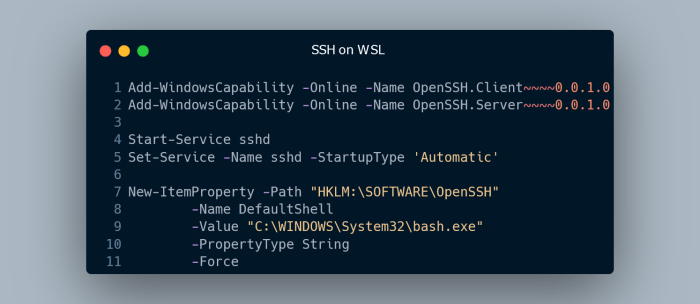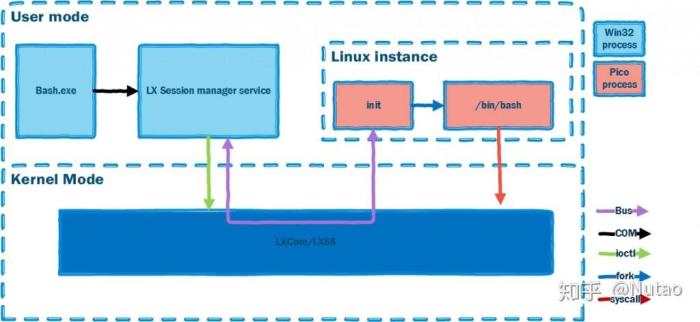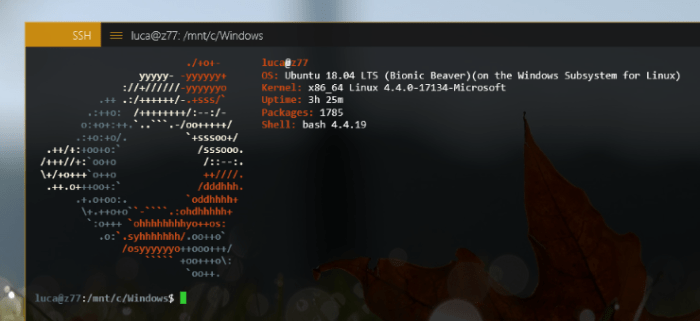In the realm of computing, the Windows Subsystem for Linux (WSL) has emerged as a game-changer, enabling users to seamlessly run Linux distributions within the Windows operating system. One of the most powerful features of WSL is its SSH server, which allows for secure remote access to your WSL environment from any device with an SSH client.
In this comprehensive guide, we will delve into the world of WSL SSH Server, exploring its benefits, installation process, configuration options, security considerations, and advanced features. Whether you’re a seasoned Linux user or new to the world of remote access, this guide will provide you with the knowledge and insights you need to harness the full potential of WSL SSH Server.
Introduction to WSL SSH Server

WSL SSH Server, a component of the Windows Subsystem for Linux (WSL), enables seamless access to remote Linux servers from within the Windows environment. This powerful tool allows users to execute commands, transfer files, and manage remote systems directly from their Windows machines.
The benefits of using WSL SSH Server are numerous. It eliminates the need for dual-booting or running virtual machines, providing a convenient and efficient way to work with Linux systems. Additionally, it offers improved performance compared to traditional SSH clients due to its integration with WSL’s optimized Linux kernel.
Use Cases
- Remote system administration and management
- Developing and testing applications on remote Linux servers
- Accessing and transferring files between Windows and Linux systems
- Troubleshooting and debugging Linux systems remotely
Installing and Configuring WSL SSH Server
WSL SSH Server is an essential component for remotely accessing your WSL environment. Here’s how to set it up:
Installing WSL SSH Server
Open Windows Terminal.
-
- Run the following command to install OpenSSH
`wsl
- -install
- d Ubuntu-20.04
- y`.
- Run the following command to install OpenSSH
Once installed, enable SSH
`sudo apt update && sudo apt install openssh-server`.
Configuring WSL SSH Server
Generate SSH keys
`ssh-keygen
-
- t rsa
- b 4096`.
Copy the public key to your authorized keys file
`cat ~/.ssh/id_rsa.pub >> ~/.ssh/authorized_keys`.
Set a password for your SSH user
`passwd`.
Restart SSH
`sudo systemctl restart ssh`.
Connecting to WSL SSH Server
Accessing your WSL SSH server involves establishing a secure connection from a remote client. This guide will walk you through different methods to connect to your WSL SSH server.
Before proceeding, ensure that your WSL SSH server is properly configured and running. Refer to the previous section for detailed instructions on setting up your WSL SSH server.
Using SSH Client
The most common method to connect to an SSH server is using an SSH client. Various SSH clients are available, such as OpenSSH, PuTTY, and MobaXterm. Here’s how to connect using OpenSSH:
-
- Open a terminal window on your remote client.
- Type the following command, replacing “username” with your WSL username and “ip_address” with the IP address of your WSL distribution:
ssh username@ip_address
- When prompted, enter your WSL password.
Using Windows Terminal
Windows Terminal is a built-in tool in Windows that allows you to connect to your WSL SSH server. Here’s how:
-
- Open Windows Terminal.
- Click on the down arrow in the tab bar and select “New tab.”
- In the new tab, type the following command, replacing “username” with your WSL username and “distribution_name” with the name of your WSL distribution:
wsl -u username --distribution distribution_name
Using File Explorer
You can also connect to your WSL SSH server using File Explorer. Here’s how:
-
- Open File Explorer.
- In the address bar, type the following path, replacing “ip_address” with the IP address of your WSL distribution:
\\ip_address\
- When prompted, enter your WSL username and password.
Managing SSH Keys

SSH keys are a crucial aspect of securing SSH connections. They provide a secure alternative to passwords, allowing for passwordless authentication and enhanced security.
With WSL SSH Server, you can easily generate, manage, and use SSH keys to establish secure connections.
Generating SSH Keys
- Open a terminal window in WSL.
- Run the following command:
ssh-keygen
-t rsa
-b 4096 - Follow the prompts to specify a location and passphrase for your key.
Managing SSH Keys
Once generated, you can manage your SSH keys using the following commands:
ssh-add: Add a key to the SSH agent.ssh-keygen: List all available SSH keys.
-lssh-keygen: Change the passphrase of an existing key.
-f ~/.ssh/id_rsa
-p
Using SSH Keys with WSL SSH Server
To use SSH keys with WSL SSH Server, add the public key to the authorized_keys file of the user you want to connect as.
- Copy the public key using the command:
cat ~/.ssh/id_rsa.pub - On the remote server, open the authorized_keys file:
sudo nano ~/.ssh/authorized_keys - Paste the public key into the file and save it.
Now, you can connect to the WSL SSH Server using your SSH key without the need for a password.
5. Firewall and Security
WSL SSH Server offers remote access to your WSL distribution, which raises security considerations. Implementing proper firewall rules and security measures is crucial to protect your system from unauthorized access and potential threats.
Firewall Configuration
To configure firewall rules for WSL SSH Server, follow these steps:
- Open Windows Defender Firewall with Advanced Security.
- In the left pane, click “Inbound Rules” and then “New Rule”.
- Select “Port” and click “Next”.
- Enter the port number (default: 22) and select “TCP”.
- Allow the connection and click “Next”.
- Select the appropriate network profiles and click “Next”.
- Name the rule and click “Finish”.
Additional Security Measures
- Use strong SSH keys to authenticate connections.
- Disable password authentication to prevent unauthorized access via weak passwords.
- Limit SSH access to specific IP addresses or subnets.
- Monitor SSH logs regularly to detect any suspicious activity.
- Keep WSL SSH Server and Windows Defender Firewall up to date with the latest security patches.
Troubleshooting Common WSL2 Server Errors

When running WSL2 Server, you may encounter various issues and errors. This guide provides solutions and tips to help you troubleshoot and fix these problems.
WSL2 Server Not Starting
If you’re unable to start the WSL2 Server service, it could be due to one of the following reasons:
- WSL2 is not installed or is not running: Ensure that you have installed WSL2 and that it is running properly.
- Firewall or security settings are blocking the service: Check your firewall settings and ensure that the WSL2 Server service is allowed to run.
- Insufficient permissions: Verify that you have sufficient permissions to start the WSL2 Server service.
WSL2 Server Not Responding
If the WSL2 Server service is not responding, it could be due to:
- Overloaded resources: Check if your system is running low on memory or other resources, which can cause the service to slow down or freeze.
- Network issues: Verify that your network connection is stable and that the WSL2 Server service has access to the internet.
- Conflicting software: Check for any other software or services that may be conflicting with the WSL2 Server service.
WSL2 Server Not Connecting to Clients
If the WSL2 Server service is unable to establish or maintain a connection with clients, the problem could be:
- Firewall or security settings: Ensure that your firewall and security settings are configured to allow incoming and outgoing network requests to the WSL2 Server service.
- Network configuration issues: Verify that your network is properly configured and that the WSL2 Server service can access the network and reach the clients.
- Client-side issues: Check if the client applications are configured to connect to the WSL2 Server service on the correct port and host.
Other Common Errors
In addition to the above, you may encounter other errors specific to your environment or configuration. To troubleshoot these issues, you can refer to the following:
- WSL2 Server Event Log: Check the Windows Event Log for any errors or warnings related to the WSL2 Server service.
- WSL2 Server Command-Line: Use the ‘wslserver’ command-line tool to troubleshoot and get more detailed information about errors.
- WSL2 Community Support: Seek help from the WSL community forums or online resources for assistance with specific issues.
Advanced Features and Customization
Advanced Features
WSL SSH Server offers advanced features for enhanced customization and performance optimization:
- Port Forwarding: Allows remote access to local resources on the WSL instance by forwarding specific ports.
- Key-Based Authentication: Enhances security by using SSH keys instead of passwords for authentication.
- Authorized Keys File: Specifies authorized SSH keys for access control, allowing specific users to connect.
- SFTP Support: Facilitates secure file transfer over SSH, enabling remote file management.
- X11 Forwarding: Allows graphical applications running on the WSL instance to be displayed on the remote client.
Performance Optimization
To enhance WSL SSH Server performance, consider the following optimizations:
- CPU and Memory Allocation: Allocate sufficient CPU and memory resources to the WSL instance to handle SSH connections effectively.
- Disable Unnecessary Services: Stop or disable non-essential services running on the WSL instance to free up resources.
- Optimize SSH Configuration: Tune SSH server settings, such as cipher algorithms and compression methods, for optimal performance.
- Use a Fast Network Connection: Ensure a stable and high-speed network connection for seamless SSH connections.
By leveraging these advanced features and performance optimizations, you can customize and enhance the WSL SSH Server to meet your specific needs and requirements.
Integrating with Other Tools
WSL SSH Server can seamlessly integrate with a wide range of tools and services, enabling users to leverage the capabilities of WSL and SSH in diverse scenarios.
Extending Functionality with Plugins
WSL SSH Server supports the use of plugins, allowing users to extend its functionality and customize it to meet specific needs. Plugins can add new features, such as support for additional authentication methods, session management tools, or integration with other applications.
Using WSL SSH Server with Visual Studio Code
Visual Studio Code, a popular code editor, offers built-in integration with WSL SSH Server. This integration allows users to connect to their WSL environment directly from Visual Studio Code, enabling them to edit and debug code seamlessly between their Windows and WSL systems.
Leveraging WSL SSH Server for Remote Development
WSL SSH Server can be utilized for remote development, allowing users to access and modify files on a remote server from their local WSL environment. This enables developers to work on projects remotely without having to set up a complex development environment on their local machine.
Integrating WSL SSH Server with Docker
WSL SSH Server can be integrated with Docker, a containerization platform, to provide access to Docker containers from within WSL. This integration allows users to manage and interact with Docker containers from their WSL environment, simplifying the development and deployment of containerized applications.
Best Practices for WSL SSH Server
When using WSL SSH Server, consider the following best practices to ensure security and efficiency: Security Measures:
Use strong passwords
Create complex and unique passwords for user accounts.
Enable two-factor authentication (2FA)
Add an extra layer of security by requiring a second form of authentication, such as a mobile device.
Keep software up to date
Regularly update the WSL SSH Server software and its dependencies to patch security vulnerabilities.
Monitor server logs
Check the server logs for suspicious activity and investigate any anomalies.
Limit user access
Grant access to the server only to authorized users and restrict their privileges. Performance Optimizations:
Use a dedicated SSH port
Configure the server to use a non-default SSH port to reduce exposure to automated attacks.
Enable compression
Compress data during SSH connections to improve performance over slow networks.
Use a fast SSH cipher
Select a fast and secure SSH cipher, such as AES-256-CBC, to optimize data encryption and decryption.
Tune server resources
Allocate sufficient CPU, memory, and network resources to the WSL SSH Server to handle the expected load.
Consider using a proxy server
Forward SSH connections through a proxy server to improve security and anonymity.
Conclusion
In conclusion, WSL SSH Server provides a seamless and secure way to access your WSL distributions from remote locations. It offers numerous benefits, including cross-platform compatibility, enhanced security, and convenient remote management.
As WSL and SSH continue to evolve, we can expect advancements in the WSL SSH Server, such as improved performance optimizations, enhanced security features, and deeper integration with other tools and services.
Future Trends and Advancements
- Performance Enhancements: Ongoing optimizations will improve the speed and efficiency of the WSL SSH Server, resulting in faster file transfers and smoother remote sessions.
- Advanced Security Features: Future updates may introduce new security measures, such as multi-factor authentication and improved key management, to further protect remote access.
- Integration with Other Tools: We can expect deeper integration with popular tools and services, such as remote desktop clients and code editors, making it even easier to manage and interact with your WSL distributions remotely.
Last Word
In conclusion, WSL SSH Server is an indispensable tool for anyone looking to access their Linux environment remotely from Windows. Its ease of use, security features, and advanced customization options make it a versatile solution for developers, system administrators, and anyone who values the power and flexibility of Linux.